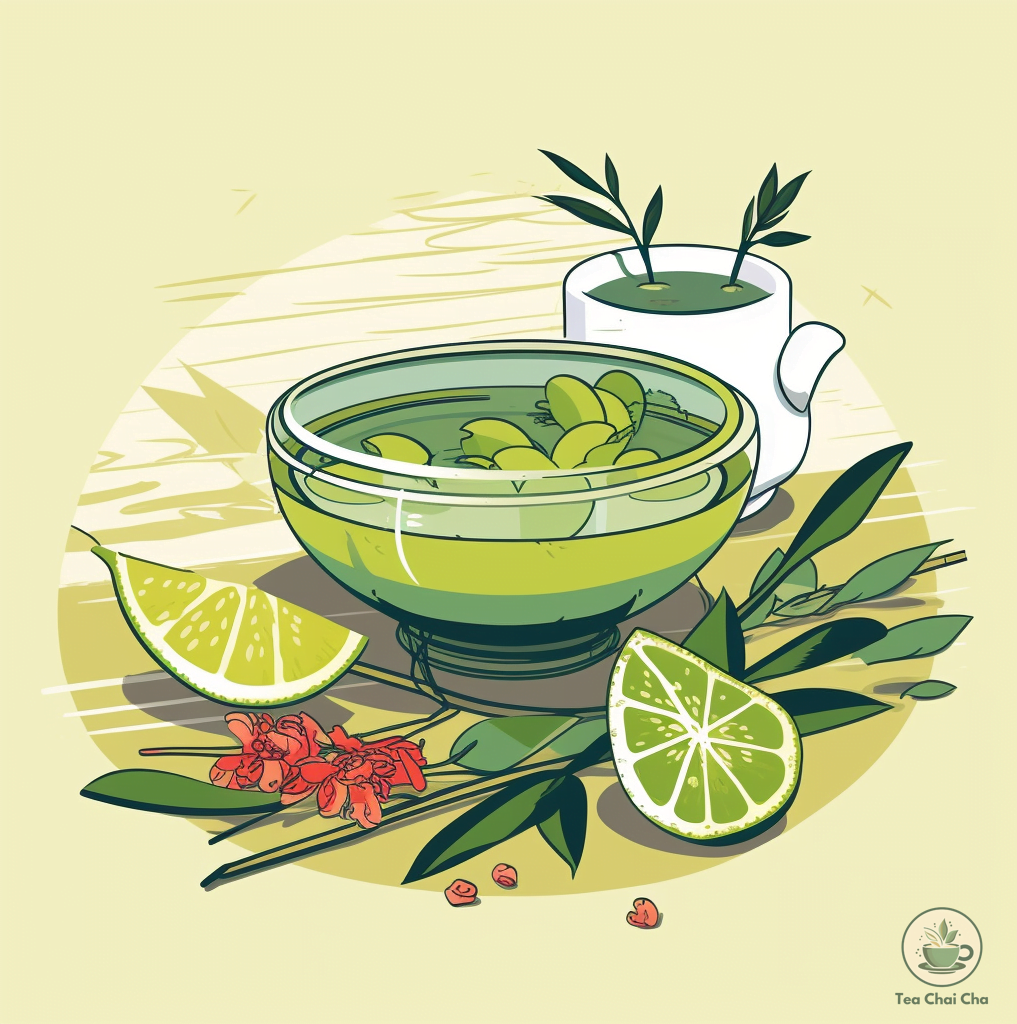Have you ever taken a sip of green tea, expecting a familiar taste but found yourself in for a surprise?
Maybe you thought it would taste like your favorite drink or something entirely different.
Well, you’re not alone in your curiosity.
Many of us have wondered, “What does green tea taste like?“
Green tea has a fresh, earthy taste with a hint of bitterness. Some describe it as a bit grassy or vegetal, like a stroll through a garden after a light rain.
It’s not overly bold like black tea, nor too delicate like white tea. Instead, it strikes a lovely balance. The taste of green tea can vary depending on the type and where it’s grown.
Japanese green teas tend to have a slightly sweeter, umami-like flavor, while Chinese green teas often have more vegetal notes.

Why Does Green Tea Taste So?
Green tea gets its unique taste from the leaves of the Camellia sinensis plant.
The leaves are rich in compounds called catechins, which give green tea its distinct flavor.
These catechins are responsible for the slightly bitter, earthy, and sometimes grassy taste.
But there’s more to it than just catechins.
The specific flavors can vary depending on factors like where the tea is grown, the time of harvest, and how the leaves are processed.
For example, Japanese green teas often have a sweeter, umami flavor, while Chinese green teas may have a more vegetal taste.
The way you brew your green tea also plays a role.
If the water temperature is too high or you steep it for too long, you can end up with a bitter cup.
So, it’s essential to follow the right brewing techniques to bring out the best in your green tea.
Is Green Tea Supposed to Taste Like Nothing?
No, green tea is not supposed to taste like nothing.
It should burst with unique, delicate flavors that can vary from grassy and vegetal to sweet and slightly nutty, depending on the type.
If you’re not experiencing these delightful tastes, it’s time to tweak your brewing method.
Don’t worry if you need a hand in brewing your green tea to perfection.
I got your back with a detailed guide on green tea brewing!
6 Different Tastes of Green Tea
When it comes to green tea, you might be surprised by the variety of flavors it can offer.
Each flavor is a result of a combination of factors, including the tea’s origin, processing method, and how it’s brewed.
Let’s explore the different tastes you can find in green tea:
1. Saltiness
Some green teas have a subtle saltiness to them.
This flavor can be reminiscent of seaweed or even a hint of ocean breeze.
It’s most commonly found in Japanese green teas like Mizudashi Sencha, which is grown near the sea.
The saltiness in these teas is influenced by the minerals in the soil and the ocean air that surrounds the tea plants.
2. Sweetness
Sweetness in green tea is a delightful surprise for many. This flavor can vary from mildly sweet to almost honey-like.
Teas like Dragonwell (Long Jing) from China often exhibit a natural sweetness.
It’s the result of the tea leaves’ natural sugars, which are preserved through careful processing.
3. Bitterness
Bitterness is a common flavor in green tea, especially if it’s steeped too long or with water that’s too hot.
But some teas, like Gyokuro, embrace a pleasant bitterness.
This bitterness is due to a higher concentration of catechins, which are antioxidants in tea leaves.
When brewed correctly, it can be a unique and enjoyable taste.
4. Sourness
Sourness in green tea is less common but can be found in teas like Hojicha.
This flavor arises from the roasting process, where the leaves are exposed to high heat.
The roasting can bring out tart and sour notes, creating a distinctive taste profile.
5. Umami
Umami is often described as a savory or brothy taste, and it’s a prized flavor in many Japanese green teas, including Matcha and Sencha.
Umami is a result of the amino acids in the tea leaves, particularly L-theanine.
It provides a rich, smooth taste that lingers on the palate.
6. Astringency and Dryness
Astringency is that puckering, dry sensation you might experience in some green teas, like Sencha or Darjeeling Green Tea.
It happens when certain compounds in the tea bind with the proteins in your saliva.
While it may sound off-putting, a touch of astringency can actually enhance the overall tea experience, adding complexity to the flavor.
What Do Different Green Teas Taste Like?
Green tea comes in a variety of flavors, each with its own unique characteristics.
Here are some of the different tastes you can experience in the world of green tea:
1. Grassy and Vegetal Flavors
Sencha: This Japanese green tea is known for its vibrant green color and a fresh, grassy flavor with a hint of seaweed.
It’s like taking a stroll through a lush meadow.
Dragonwell (Longjing): A famous Chinese green tea, Dragonwell has a distinct chestnut-like flavor with a subtle grassy undertone.
It’s often described as smooth and refreshing.
2. Sweet and Umami Flavors
Gyokuro: Another Japanese gem, Gyokuro boasts a rich, sweet, and umami taste.
It’s often referred to as the “king of green tea” due to its luxurious flavor.
Houjicha: This roasted Japanese green tea has a toasty, nutty flavor with minimal bitterness.
It’s like sipping on a warm, comforting cup of toasted goodness.
3. Nutty and Seaweed Notes
Genmaicha: A unique Japanese green tea, Genmaicha combines green tea leaves with roasted brown rice, giving it a toasty, nutty aroma and flavor.
Some even detect a subtle hint of seaweed.
Kukicha: Also known as “twig tea,” Kukicha is made from the stems and twigs of the tea plant.
It has a mild, nutty taste with a touch of sweetness.
4. Floral and Aromatic Profiles
Jasmine Green Tea: This scented green tea from China is infused with jasmine blossoms, offering a delicate floral aroma and a light, sweet taste.
Lavender Sencha: For a soothing experience, try Lavender Sencha, which combines the fresh grassiness of sencha with the calming essence of lavender flowers.
5. Citrusy and Fruity Notes
Yuzu Sencha: Yuzu is a citrus fruit that adds a zesty, tangy twist to sencha, creating a refreshing and fruity green tea.
Mango Green Tea: Infused with the tropical flavor of mango, this green tea brings a sweet and slightly tangy taste to your cup.

Which Green Tea Type Is Best for Who?
Can’t find your perfect match? I got you!
Here are just a few of the famous green teas, and each offers a unique taste and experience.
Feel free to explore and find your favorite!
| Green Tea Type | Origin | Flavor Profile | Notable Features | Best For |
|---|---|---|---|---|
| Sencha | Japan | Slightly Vegetal, Slightly Bitter | Common Japanese Green Tea | Beginners, Everyday Sipper |
| Matcha | Japan | Rich Umami, Earthy | Powdered Green Tea for Ceremonies | Enthusiasts, Energy Boost |
| Dragon Well | China | Chestnut-like, Nutty, Sweet | Known for Its Flat, Smooth Leaves | Those Who Like Sweetness |
| Gyokuro | Japan | Deep Umami, Strong Bitterness | Grown in Shade for Intense Flavor | Bitterness Enthusiasts |
| Jasmine Green Tea | China | Jasmine Fragrance, Lightly Sweet | Infused with Jasmine Flowers | Floral Tea Lovers |
| Hojicha | Japan | Toasted, Nutty, Low Astringency | Roasted for a Unique Flavor | Roasted Flavor Fans |
| Gunpowder | China | Smoky, Bold, Slightly Bitter | Rolled Leaves Resemble Gunpowder | Bold Tea Enthusiasts |
| Bancha | Japan | Mild, Grassy, Slightly Astringent | Made from Mature Tea Leaves | Those Seeking Mild Flavor |
| Longjing (Dragon Well) | China | Sweet, Fresh, Slightly Nutty | Pan-Fried for a Flat Shape | Classic Green Tea Enthusiasts |
| Chun Mee | China | Tangy, Slightly Smoky, Sweet | Known as “Precious Eyebrow” | Tangy Tea Lovers |
Effect of Green Tea Processing on Flavor
The way green tea is processed can have a profound impact on its flavor profile.
Japanese and Chinese green teas, two of the most renowned varieties, undergo distinct processing methods that result in different tastes.
-> Japanese Green Tea Processing
When it comes to Japanese green tea processing, the Steaming Method stands out as a key factor influencing flavor.
The leaves are steamed right after harvesting, locking in their vibrant green color and imparting a fresh, slightly vegetal and grassy taste.
Another defining feature is Shade-Grown Tea, where tea bushes are covered with shade cloths before harvest.
This technique enhances the production of chlorophyll and amino acids, resulting in a sweeter and more umami-rich flavor, exemplified by teas like Matcha.
-> Chinese Green Tea Processing
In China, the processing methods bring a different character to green tea.
Pan-Frying and Oven-Drying replace steaming, giving Chinese green teas a toasty and nutty flavor profile, as seen in Dragon Well.
Chinese green teas also undergo a Withering and Slight Oxidation process before heating, which contributes to a diverse range of flavors.
Teas like Chun Mee develop a tangy and slightly smoky taste due to this oxidation.
Other Teas That Taste like Green Tea
While green tea boasts its own unique flavor profile, there are other types of teas, from various tea categories, that can replicate aspects of its taste.
These teas offer a refreshing alternative for those looking to explore new flavors while still enjoying some of the familiar notes found in green tea.
-> White Tea
White tea, like Silver Needle or Bai Mu Dan, shares a certain delicacy and freshness with green tea.
Its minimal oxidation process retains a light and subtly sweet taste, reminiscent of the milder green tea varieties.
-> Yellow Tea
Yellow teas such as Junshan Yinzhen or Huoshan Huangya offer a mellow and slightly sweet flavor profile akin to green tea.
They undergo a unique yellowing step during processing, which imparts a distinct character while preserving some green tea-like qualities.
Oolong Tea
Certain lightly oxidized oolong teas, like Tie Guan Yin and Baozhong, can bridge the gap between green and oolong teas.
They exhibit floral and vegetal notes that evoke the freshness of green tea while offering the complexity of oolong.
Herbal Teas
Some herbal teas, such as Lemongrass or Mint, can provide a similar grassy and refreshing experience reminiscent of green tea.
While herbal teas lack caffeine, they capture the herbal and soothing essence often associated with green tea.

What Flavors Pair Well with Green Tea
Green tea, with its unique taste profile, offers a world of culinary possibilities when it comes to pairing with different foods.
Whether you’re looking for complementary or contrasting flavors, here are some tasty examples of foods that harmonize beautifully with the taste of green tea.
-> Sushi and Sashimi
The subtle bitterness and umami notes in green tea complement the clean and fresh flavors of sushi and sashimi.
The combination enhances the overall dining experience, making it a favorite choice among sushi enthusiasts.
-> Asian Cuisine
Green tea’s vegetal and slightly grassy undertones make it a fantastic companion for a wide range of Asian dishes, including stir-fries, dim sum, and Thai curries.
It balances the spiciness and complexity of these dishes with its refreshing qualities.
-> Light Desserts
Pairing green tea with light desserts like matcha-flavored ice cream, green tea mochi, or green tea cheesecake creates a yummy blend of sweet and earthy flavors.
The tea’s bitterness contrasts beautifully with the sweetness of these treats.
-> Fruit
Fresh fruits, such as sliced apples, kiwi, or citrus segments, offer a refreshing contrast to green tea’s taste.
The fruity sweetness complements the tea’s slightly astringent character.
-> Nuts
Roasted nuts, like almonds or cashews, pair excellently with green tea.
The nuttiness adds depth to the tea’s flavor, creating a satisfying combination of tastes and textures.

-> Light Pastries
Delicate pastries such as green tea macarons or matcha-flavored shortbread cookies are a match made in heaven with green tea.
They share a similar subtle sweetness that enhances the tea-drinking experience.
-> Seafood
The fresh and oceanic flavors of seafood, whether it’s grilled shrimp, sushi rolls, or smoked salmon, work harmoniously with green tea’s natural taste.
The pairing brings out the best in both the tea and the seafood.
-> Savory Snacks
Green tea can be an ideal accompaniment to savory snacks like seaweed snacks, rice crackers, or wasabi peas.
Its mild bitterness and umami notes create a satisfying contrast.
How to Pick the Best Tasting Green Tea
Selecting the perfect green tea can be overwhelming, and the key is to consider various factors that influence tea’s taste.
Whether you’re a seasoned green tea connoisseur or new to this flavorful world, here are some tips to help you pick the best tasting green tea for your palate.
1. Consider the Tea Type
Start by exploring the different types of green tea, such as Sencha, Matcha, Dragon Well, or Jasmine Green Tea.
Each type offers a unique flavor profile.
So choose one that aligns with your taste preferences, whether it’s fresh and grassy or sweet and nutty.
2. Check the Tea Grade
Green teas come in various grades, often categorized as ceremonial, premium, or culinary grade.
Ceremonial and premium grades tend to have the best flavor, while culinary grades are more suitable for cooking.
Opt for higher grades for a superior tasting experience.
3. Examine the Leaf Quality
Inspect the appearance of the tea leaves.
High-quality green tea leaves should be intact, whole, and vibrant in color.
Avoid teas with broken or discolored leaves, as they can indicate lower quality and less flavor.
4. Smell the Aroma
Before purchasing, take a moment to inhale the aroma of the green tea.
A fresh and pleasant scent often hints at a flavorful cup.
Look for teas with a fragrant and inviting aroma that appeals to your senses.
5. Check the Harvest Date
Fresher is usually better when it comes to green tea.
Check the harvest date on the packaging, if available.
Teas that are recently harvested are more likely to have a vibrant and robust taste.
6. Consider the Origin
Green tea’s flavor can vary depending on where it’s grown.
Japanese green teas tend to be sweeter and more umami, while Chinese green teas offer a range of flavors from nutty to toasty.
Explore different origins to find your preferred taste.
7. Brewing Method Matters
Remember that the way you brew green tea can greatly impact its taste.
Pay attention to water temperature, steeping time, and the amount of tea leaves used.
Experiment to find the ideal tea brewing method that brings out the best flavor.
8. Read Reviews and Recommendations
Don’t hesitate to read reviews or seek recommendations from fellow tea enthusiasts or reputable tea vendors.
Their insights can guide you to exceptional green teas that have received positive feedback.
Related Guides on Tea Taste
- What Does Tea Taste Like? How to Describe Tea Taste
- What Does Black Tea Taste Like?
- What Does White Tea Taste Like? – Complete Guide
Related Guides on Green Tea Taste
Frequently Asked Questions (FAQs)
Does green tea taste good?
Yes, green tea can taste good, but it depends on personal preference. Some find it delightful, while others may not enjoy its taste.
Is green tea sweet or bitter?
Green tea can be both sweet and bitter, with the level of sweetness or bitterness varying depending on the specific type of green tea and how it’s brewed.
How do you drink green tea if you don't like it?
If you don’t like the taste of green tea, you can try adding natural sweeteners like honey or lemon to make it more palatable. Experimenting with different green tea varieties and brewing methods might also help you find a flavor profile you enjoy.
